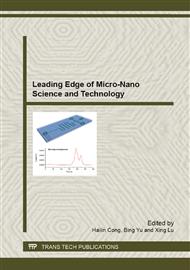[1]
D. Wang, W. Jiang, H. Gao, Z.J. Jiang, Effect of supercritical carbon dioxide on the crystallization behavior of poly(ether ether ketone), J. Polym. Sci., Part B: Polym. Phys. 45 (2007) 173-183.
DOI: 10.1002/polb.21150
Google Scholar
[2]
M. Yamaguchi, K. Sucuki, Rhelogical properties and foam processability for blends of linear and crosslinked polyethylenes, J. Polym. Sci., Part B: Polm. Phys. 39(2001) 2159-2167.
DOI: 10.1002/polb.1189
Google Scholar
[3]
B.L. Lee, The relationships between mixing and properties of filled polymers and foams, Polym. Composites 6(1985) 115-122.
DOI: 10.1002/pc.750060210
Google Scholar
[4]
H. Liu, C. Han, L. Dong, Preparation and characterization of poly(ε-carprolactone)/calcium carbonate nanocomposites and nanocomposite foams, Polym. Composites 31(2010) 1653-1661.
DOI: 10.1002/pc.20955
Google Scholar
[5]
J.B. Jeon, G.Y. Jeong, G. B. Min, S.W. Lyoo, Lead ion removal characteristics of poly(lactic acid)/hydroxyapatite composite foams prepared by supercritical CO2 process, Polym. Composites 32(2011) 1405-1415.
DOI: 10.1002/pc.21164
Google Scholar
[6]
Y.W. Di, S. Iannace, E. Di Maio, L. Nicolais, Poly(lactic acid)/organoclay nanocomposites: Thermal, rheological properties and foam processing, J. Polym. Sci., Part B: Polm. Phys. 43 (2005) 689-698.
DOI: 10.1002/polb.20366
Google Scholar
[7]
O. Almanza; M.A. Rodriguez-Perez, J.A. De Saja, Prediction of the radiation term in the thermal conductivity of crosslinked closed cell polyolefin foams, J. Polym. Sci., Part B: Polym. Phys. 38(2000) 993-1004.
DOI: 10.1002/(sici)1099-0488(20000401)38:7<993::aid-polb10>3.0.co;2-j
Google Scholar
[8]
S.M. Seraji, M.K. Razavi Aghjeh, M. Davari, M. Salami Hosseini, Sh. Khelgati, Effect of clay dispersion on the cell structure of LDPE/clay nanocomposite foam, Polym. Compos. 32(2011) 1095-1105.
DOI: 10.1002/pc.21127
Google Scholar
[9]
Z.M. Xu, X.L. Jiang, T. Liu, G.H. Hu, L. Zhao, Z.N. Zhu, W.K. Yuan, Foaming of polypropylene with supercritical carbon dioxide, J. Supercritical Fluids 41(2007) 299-310.
DOI: 10.1016/j.supflu.2006.09.007
Google Scholar
[10]
B. Zhu, W.B. Zha, J.T. Yang, Layered-silicate based polystyrene nanocomposite microcellular foam using supercritical carbon dioxide as blowing agent, Polymer 51(2010) 2177-2184.
DOI: 10.1016/j.polymer.2010.03.026
Google Scholar
[11]
K.A. Arora, T.J. McCarthy, A.J. Lesser, Preparation and characterization of microcellular polystyrene foams processed in supercritical carbon dioxide, Macromolecules 31(1998) 4614-4620.
DOI: 10.1021/ma971811z
Google Scholar


